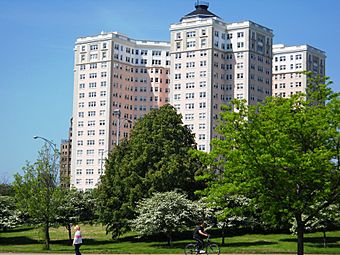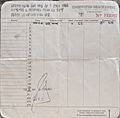Edgewater Beach Hotel facts for kids
Quick facts for kids Edgewater Beach Hotel |
|
|---|---|

Postcard of Edgwater Beach Hotel showing the 1916 and 1924 buildings.
|
|
| General information | |
| Architectural style | Spanish Colonial Revival |
| Location | 5301-5355 N Sheridan Road Chicago, Illinois |
| Country | United States |
| Coordinates | 41°59′1″N 87°39′17″W / 41.98361°N 87.65472°W |
| Construction started | 1915 |
| Completed | 1924 |
| Opened | June 3, 1916 |
| Demolished | 1971 |
| Cost | US $9 million |
| Client | John Tobin Connery and James Patrick Connery |
| Design and construction | |
| Architect | Marshall and Fox |
|
Edgewater Beach Apartments
|
|

The Edgewater Beach Apartments, built in 1927, sole portion of complex now standing
|
|
| Location | 5555 North Sheridan Road Chicago, Illinois |
|---|---|
| Built | 1928 (co-op apartments) |
| Architect | Marshall and Fox |
| Architectural style | Beaux-arts / Historism |
| MPS | Bryn Mawr Avenue Historic District |
| NRHP reference No. | 94000979 |
| Added to NRHP | August 16, 1994 |
The Edgewater Beach Hotel was a famous resort hotel in Chicago, Illinois. It sat right on the shore of Lake Michigan. Architects Benjamin H. Marshall and Charles E. Fox designed it. The first part of the hotel opened in 1916. It quickly became a popular spot for movie stars, sports heroes, and even important leaders like Martin Luther King Jr..
The Edgewater Beach Apartments were built next to the hotel in 1928. They were part of the same resort complex. The apartments were a "sunset pink" color, which matched the "sunrise yellow" of the hotel. Today, the apartments are the only part of the original complex still standing. They are listed on the National Register of Historic Places, which means they are important historical buildings.
Contents
Designing a Grand Hotel
The Edgewater Beach Hotel was designed by the Chicago architects Marshall and Fox. They started planning it in 1915. The complex included several buildings and fun outdoor areas.
What Was the Hotel Like?
The main hotel building opened on June 3, 1916. It had a unique cross shape and 400 rooms. It was so popular that more rooms were added in 1919. Later, in 1923, a huge 19-story tower was built. This tower had 600 more rooms and opened in 1924.
The tower had a stepped design, meaning it got narrower as it went up. It connected to the main building through a large hall called the Passaggio. The ground floor along Sheridan Road had fancy shops. On the Lake Michigan side, there was an outdoor dance floor and stage called the Beach Walk. It had beautiful marble tiles.
Fun Features and Location Changes
The hotel had a long, private beach, about 1,200 feet (365 meters) long. Guests could even take a seaplane directly to downtown Chicago from the hotel! When the hotel was first built, it was only about 20 feet (6 meters) from Lake Michigan.
However, things changed. In 1933, a major road called Lake Shore Drive was extended. This road was built on new land, which separated the hotel from its private beach. After this, the hotel added a swimming pool in 1953 so guests could still swim.
A Place for Stars and Music
The Edgewater Beach Hotel was a favorite spot for many famous people. Stars like Marilyn Monroe, Frank Sinatra, Judy Garland, and Charlie Chaplin stayed there. U.S. Presidents Franklin D. Roosevelt and Dwight D. Eisenhower also visited.
The hotel was famous for its live music. Big bands, like those led by Benny Goodman and Glenn Miller, played there. Their music was even broadcast on the hotel's own radio station, WEBH. This station was an early version of today's WGN radio. In winter, the bands played in the Marine Dining Room. In summer, they moved outdoors to the Beach Walk. Guests could also enjoy drinks at the Yacht Club.
A Historic Speech
In January 1963, Martin Luther King Jr. gave an important speech at the hotel. It was during the "National Conference on Religion and Race." He spoke about justice and love, marking 100 years since the Emancipation Proclamation. King called it "the most significant and historic" meeting for fighting racism. President John F. Kennedy also sent a message of support for civil rights, which was read at the conference.
The Apartments That Remain
The Edgewater Beach Co-op Apartments, built in 1928, are the only part of the original hotel complex still standing. They are part of the Bryn Mawr Historic District. The architect, Benjamin Marshall, designed these apartments to be very fancy, just like his other famous projects in Chicago.
The apartments are easy to spot from Lake Shore Drive because of their unique "sunset pink" color. This color was chosen to go with the "sunrise yellow" of the hotel when both buildings were standing. Today, the ground floor of the apartment building has shops, including a flower shop and a restaurant.
Why Did It Close?
The Edgewater Beach Hotel closed suddenly on December 21, 1967. The hotel had faced money problems. It tried to attract more business by hosting conventions, but it didn't work out.
For a short time, Loyola University used the hotel as a dormitory for students. But by 1969, the students moved out. The hotel complex was then torn down between 1969 and 1971.
After the hotel was demolished, new modern apartment buildings were built in its place. Only the Edgewater Beach Apartments and their gardens remain as a reminder of the grand resort that once stood there.
Images for kids












